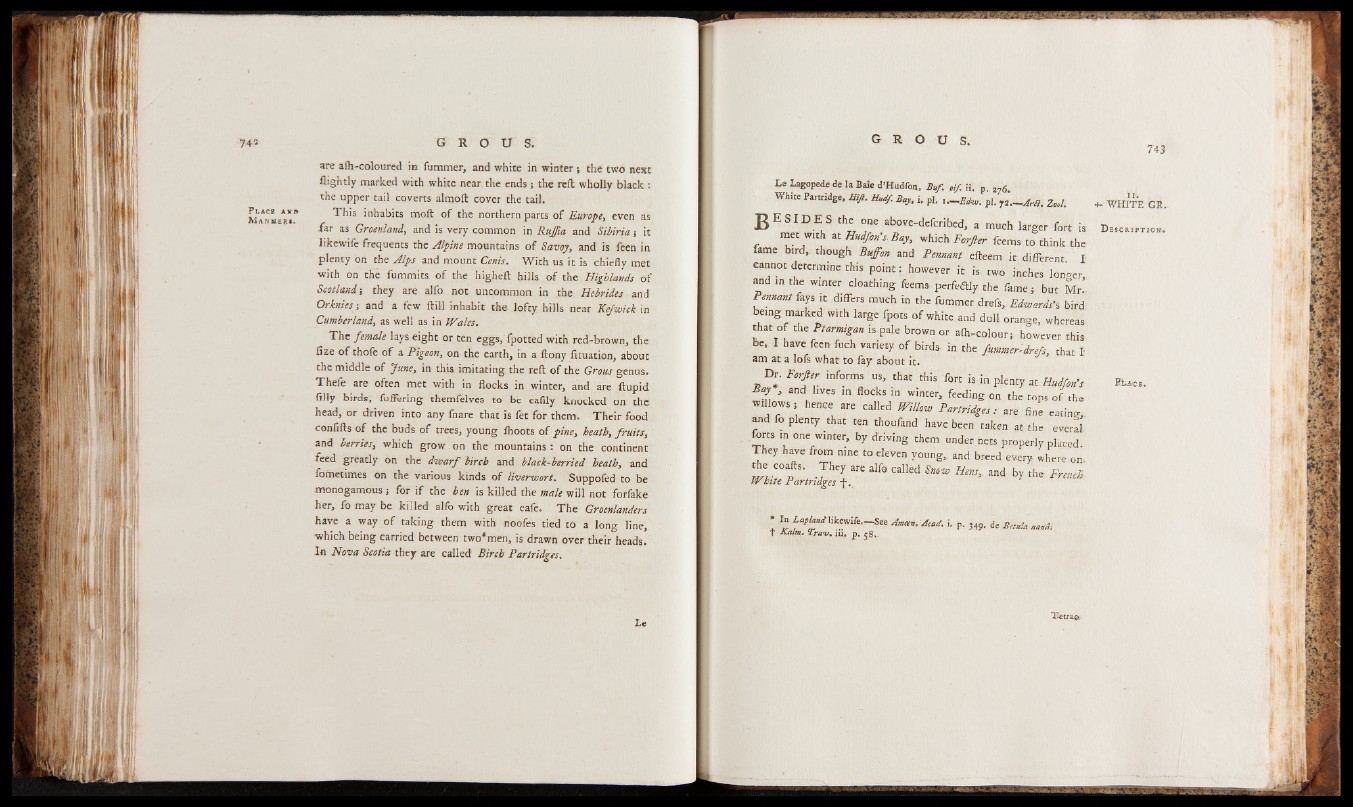
P l a c e a n s
M a n n e r * ,
are aft-coloured in fummer, and white in winter; the two next
flightly marked with white near the ends j the reft wholly black :
the upper tail coverts almoft cover the tail.
This inhabits moft of the northern parts of Europe, even as
far as Groenland, and is very common in Ruffia and Sibiria -, it
likewife frequents the Alpine mountains of Savoy, and is feen in
plenty on the Alps and mount Cents. ^VTth us it is chiefly met
with on the fummits of the higheft hills of the Highlands of
Soot land; they are alfo not uncommon in the Hebrides and
Orknies; and a few ftill inhabit the lofty hills near Kefwick in
Cumberland, as well as in Wales.
The female lays eight or ten eggs, fpotted with red-brown, the
fize of thole of a Pigeon, on the earth, in a ftony fituation, about
the middle of June, in this imitating the reft of the Grous genus.
Thefe are often met with in flocks in winter, and are ftupid
filly birds, fuffering themfelves to be eafily knocked on the
head, or driven into any fnare that is fet for them. Their food
confifts of the buds of trees, young lhoots of pine, heath, fruits,
and berries, which grow on the mountains : on the continent
feed greatly on the dwarf birch and black-berried heath, and
fometimes on the various kinds of liverwort. Suppofed to be
monogamous ; for if the hen is killed the male will not forfake
her, fo may be killed alfo with great eafe. The Groenlanders
have a way of taking them with noofes tied to a long line,
which being carried between two* men, is drawn over their heads.
In Nova Scotia they are called Birch Partridges.
Le
743
LeLagopededelaBaied'Hudfon, Buf. oif. ii. p 2j6,
White Partridge, Htft. HuJ/. Bay, i. pi. pL f r M s M M +. WHITE GR.
B ^JlwptH" T ab°ve-defcribed, a much larger fort is D ..« .,x .o ,.
met with at Hudfon s Bay, which Forfter feems to think the
fame bird, though Buff on and Pennant efteem it different I
cannot determine this point: however it is two inches longer
and in the winter cloathing feems perfeftly the fames but Mr-
Pennant fays it differs much in the fummer drefs, Edwards’s bird
being marked with large fpots of white and dull orange, whereas
that of the Ptarmigan is pale brown or aft-colour; however this
Be, I have feen fuch variety of birds in the fum m er-drefs, that I
am at a lofs what to fay about it.
Dr. Forfter informs us, that this fort is in plenty at Hudfon’s
Bay , and lives in flocks in winter, feeding on the tops of the
willows i hence are called Willow Partridges: are fine eating,
and fo plenty that ten thoufand have been taken at the everal
forts m one winter, by driving them under, nets properly placed..
They have from nine to eleven young, and breed every where on
fte coafts. They are alfo called Snow Hens, and by the French
Whitt Partridges -f*v
t
In Lapland likewife— See Amcen, Acad,
Kalm. Trav, iii, p, £8«.
î' P* 349* Ret til a nandi
Tretraa gig
iii
iM m
§rM| ■
m